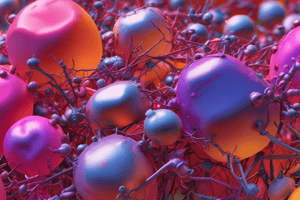Podcast
Questions and Answers
Which of the following is an oncogenic virus linked to cancer?
Which of the following is an oncogenic virus linked to cancer?
- Epstein-Barr virus (EBV) (correct)
- Rotavirus
- Influenza virus
- Varicella-zoster virus (VZV)
Which mechanism of carcinogenesis is associated with the formation of pyrimidine dimers in DNA?
Which mechanism of carcinogenesis is associated with the formation of pyrimidine dimers in DNA?
- Mutation in p53 gene
- Nonionizing radiation (correct)
- Dysregulation of cell cycle regulators
- Activation of ras oncogene
Which gene is associated with a subset of breast carcinomas?
Which gene is associated with a subset of breast carcinomas?
- ERBB2 (correct)
- KRAS
- BRCA1
- TP53
Which syndrome is associated with mutations in p53 gene?
Which syndrome is associated with mutations in p53 gene?
Which type of mutations in tumor suppressor genes is characterized by unilateral retinoblastoma?
Which type of mutations in tumor suppressor genes is characterized by unilateral retinoblastoma?
Study Notes
Carcinogenic Agents and Oncogenic Viruses Summary
- Carcinogenic agents include Aflatoxins, Alkylating agents, Alcohol, Arsenic, Asbestos, Cigarette smoke, Nitrosamines, Naphthylamine, Vinyl chloride, and certain metals and silica
- Oncogenic viruses linked to cancer are Epstein-Barr virus (EBV), HHV-8, Hepatitis B and C viruses (HBV and HCV), HTLV-1, and high-risk HPV subtypes (e.g., 16, 18, 31, 33)
- Radiation, both ionizing (from nuclear reactor accidents and radiotherapy) and nonionizing (UVB sunlight), is associated with various cancers
- Specific cancers associated with these agents and viruses include hepatocellular carcinoma, leukemia/lymphoma, squamous cell carcinoma of oropharynx and upper esophagus, pancreatic carcinoma, and others
- Mechanisms of carcinogenesis include the formation of pyrimidine dimers in DNA due to nonionizing radiation, activation of ras oncogene, and dysregulation of cell cycle regulators and tumor suppressor genes
- Tumor suppressor genes, such as p53 and Rb, regulate cell growth and decrease the risk of tumor formation by controlling the cell cycle and inducing apoptosis if DNA repair is not possible
- Growth factors, growth factor receptors, signal transducers, nuclear regulators, and cell cycle regulators play key roles in cancer development through mechanisms like overexpression, amplification, and point mutations
- Specific oncogenes and their associated cancers include ERBB2 in subset of breast carcinomas, ABL in chronic myeloid leukemia (CML), and c-MYC in Burkitt lymphoma
- Mutations in p53 and Rb genes are associated with Li-Fraumeni syndrome and familial retinoblastoma, respectively
- Germline mutations in tumor suppressor genes can lead to familial cancer syndromes characterized by the propensity to develop multiple types of carcinomas and sarcomas
- Sporadic mutations in tumor suppressor genes are characterized by unilateral retinoblastoma, while germline mutations result in bilateral retinoblastoma and osteosarcoma
- These mechanisms and entities contribute to our understanding of how various environmental and viral factors contribute to the development of cancer.
Studying That Suits You
Use AI to generate personalized quizzes and flashcards to suit your learning preferences.
Description
Test your knowledge of carcinogenic agents and oncogenic viruses with this quiz. Explore the specific agents and viruses linked to cancer, the mechanisms of carcinogenesis, and the association of oncogenes and tumor suppressor genes with various cancers.




